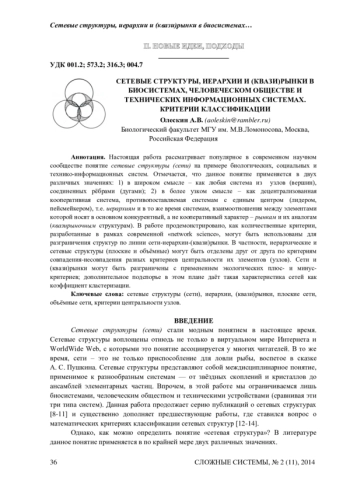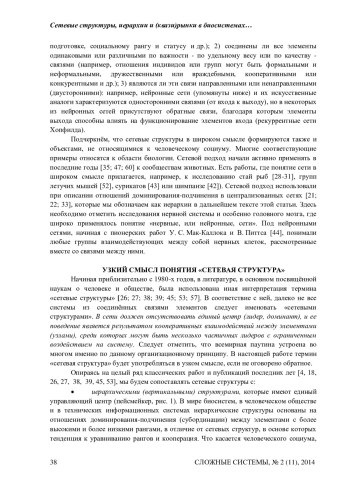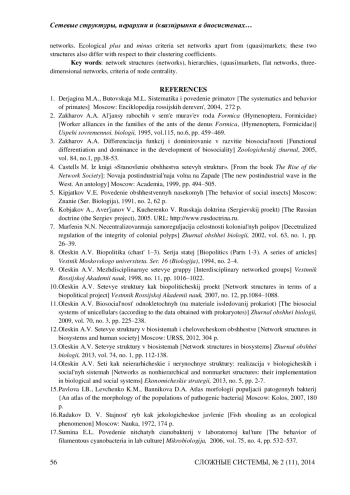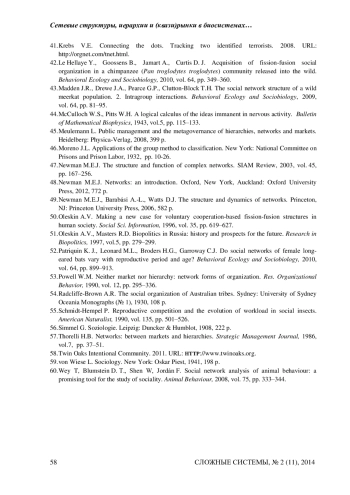Дерягина М.А., Бутовская М.Л. Систематика и поведение приматов. М.: Энциклопедия российских деревень, 2004. 272 c. EDN: RAOETP
Захаров А.А. Альянсы рабочих в семье муравьев рода Formica (Hymenoptera, Formicidae)//Успехи соврем. биологии. -1995. -Т. 115, № 6. -С. 459-469.
Захаров А.А. Дифференциация функций и доминирование в развитие биосоциальности//Зоол. журн. -2005. -Т. 84, № 1. -С.38-53. EDN: HSTUFP
Кастельс М. Из книги «Становление общества сетевых структур». В кн.: Новая постиндустриальная волна на Западе. Антология. -М.: Academia, 1999. -C. 494-505.
Кипятков В.Е. Поведение общественных насекомых. -М.: Знание (Сер. Биология), 1991. -№ 2. -62 с.
Кобяков А., Аверьянов В., Кучеренко В. Русская доктрина (Сергиевский проект). 2005. URL: http://www.rusdoctrina.ru.
Марфенин Н.Н. Нецентрализованная саморегуляция целостности колониальных полипов//Журн. общ. биол. -2002. -Т. 63, № 1. -С. 26-39. EDN: MPMZWD
Олескин А.В. Биополитика (часть 1-3). Серия статей//Вест. Моск. ун-та. Сер. 16 (Биология). -1994. -№ 2-4.
Олескин А.В. Междисциплинарные сетевые группы//Вестн. Росс. Акад. наук. -1998. -№ 11. -С. 1016-1022.
Олескин А.В. Сетевые структуры как биополитический проект//Вестн. Росс. Акад. наук. -2007. -№ 12. -С. 1084-1088. EDN: IBKDWF
Олескин А.В. Биосоциальность одноклеточных (на материале исследований прокариот)//Журн. общ. биол. -2009. -Т. 70, № 3. -С. 225-238. EDN: KAVOHR
Олескин А.В. Сетевые структуры в биосистемах и человеческом обществе. -М: URSS, 2012. -304 c.
Олескин А.В. Сетевые структуры в биосистемах//Журн. общ. биол. -2013. -Т.74, № 1. -С.112-138. EDN: QAZNPF
Олескин А.В. Сети как неиерархические и нерыночные структуры: реализация в биологических и социальных системах//Экономические стратегии. -2013. -№ 5. -С. 2-7. EDN: RBMSSD
Павлова И.Б., Левченко К.М., Банникова Д.А. Атлас морфологии популяции патогенных бактерий. -М.: Колос, 2007. -180 c. EDN: QKQKWF
Радаков Д. В. Стайность рыб как экологическое явление. -М.: Наука, 1972. -174 c.
Сумина Е.Л. Поведение нитчатых цианобактерий в лабораторной культуре//Микробиология. -2006. -Т. 75, № 4. -С.532-537. EDN: OPCXMD
Чучкевич М.М. Основы управления сетевыми организациями. -М.: Институт социологии РАН, 1999. -40 c.
Шапиро Дж.А. Бактерии как многоклеточные организмы//В мире науки. -1988. -№ 8. -С.46-55.
Almaas E., Vázquez A., Barabási A.-L. Scale-free networks in biology. «Biological networks. Complex systems and interdisciplinary science. Vol. 3» Singapore, Hackensack (NJ), London: World Scientific Publishing Co. Pte. Ltd., 2007, pp.1-21.
Appleby M.C. The probability of linearity in hierarchies. Animal Behaviour, 1983, vol.31, pp. 600-608.
Archie E.A., Morrison T.A., Foley C.A.H., Moss C.J., Alberts S.C. Dominance rank relationships among wild female African elephants Loxodonta africana. Animal Behaviour, 2006, vol. 71, pp. 117-127.
Barabási A.-L. Linked: the new science of networks. New York: Perseus, 2002, 490 p. СЛОЖНЫЕ СИСТЕМЫ, № 2 (11), 2014 53 Сетевые структуры, иерархии и (квази)рынки в биосистемах….
Barnes J. Class and committees in a Norwegian island parish. Human Relations, 1954, vol.7, pp. 39-58.
Borgatti S.P., Everett M.G., Johnson J.C. Analyzing social networks. London, Thousand Oaks (CA), New Delhi, Singapore: SAGE Publications, Ltd., 2013, 278 p.
Börzel T. Organizing Babylon -on the different conceptions of policy networks. Public Administration, 1998, vol. 76, pp. 253-273.
Castells M. The rise of the network society. The information age: economy, society and culture (Vol. I). Cambridge, MA, Oxford: Blackwell, 1996, 299 p.
Couzin I.D., Krause J., James R., Ruxton G.D., Franks N.R. Collective memory and spatial sorting in animal groups. J. Theor. Biol., 2002, vol. 218, pp. 1-11. EDN: AZYOYI
Croft D.P., Krause J., James R. Social networks in the guppy (Poecilia reticulata)//Proceedings of the Royal Society London B (Biology Letters), 2004, vol. 271, pp. S516-S519.
Croft D.P., James R., Ward A.J.W., Botham M.S., Mawdsley D., Krause J. Assortative interaction and social networks in fish. Oecologia, 2005, vol.143, pp. 211-219.
Croft D. P., James R., Krause J. Exploring animal social networks. Princeton University Press. Princeton, NJ: Princeton University Press, 2008. 192 p.
Davies A., Gardner B.B., Gardner M.R. Deep South. Chicago: University of Chicago Press, 1941,118 p.
de Vries H., Stevens J.M.G., Verdaecke H. Measuring and testing the steepness of dominance hierarchies. Animal Behaviour, 2006, vol. 71, pp. 585-592.
Freeman L.C. Centrality in social networks. Conceptual clarification. Social Networks, 1979, vol.1, pp. 215-239.
Hill R. A., Bentley R. A., Dunbar R. I. M. Network scaling reveals consistent fractal pattern in hierarchical mammalian societies. Biol. Lett., 2008, vol. 4(6), pp. 748-751.
Hölldobler B., Wilson E. O. The superorganism: the beauty, elegance, and strangeness of insect societies. New York: W. W. Norton, 2009, 522 p.
Jennings H. Leadership and isolation: A study of personality in interpersonal relations. New York: Longmans, 1943, 243 p.
Kahler M. Networked policies: agencies, power and governance. «Networked Politics: Agency, Power, and Governance». San Diego: Univ. California, 2009a, pp. 1-20.
Kahler M. Collective action and clandestine networks: the case of Al Qaeda. «Networked Politics: Agency, Power, and Governance». San Diego: Univ. California, 2009b, pp. 103-124.
Krebs V.E. Mapping networks of terrorist cells. Connections, 2002, vol. 24, pp. 43-52.
Krebs V.E. Connecting the dots. Tracking two identified terrorists. 2008. URL: http://orgnet.com/tnet.html.
Le Hellaye Y., Goossens B., Jamart A., Curtis D. J. Acquisition of fission-fusion social organization in a chimpanzee (Pan troglodytes troglodytes) community released into the wild. Behavioral Ecology and Sociobiology, 2010, vol. 64, pp. 349-360.
Madden J.R., Drewe J.A., Pearce G.P., Clutton-Block T.H. The social network structure of a wild meerkat population. 2. Intragroup interactions. Behavioral Ecology and Sociobiology, 2009, vol. 64, pp. 81-95.
McCulloch W.S., Pitts W.H. A logical calculus of the ideas immanent in nervous activity. Bulletin of Mathematical Biophysics, 1943, vol. 5, pp. 115-133.
Meulemann L. Public management and the metagovernance of hierarchies, networks and markets. Heidelberg: Physica-Verlag, 2008, 399 p.
Moreno J.L. Applications of the group method to classification. New York: National Committee on Prisons and Prison Labor, 1932, pp. 10-26.
Newman M.E.J. The structure and function of complex networks. SIAM Review, 2003, vol. 45, pp. 167-256.
Newman M.E.J. Networks: an introduction. Oxford, New York, Auckland: Oxford University Press, 2012, 772 p.
Newman M.E.J., Barabási A.-L., Watts D.J. The structure and dynamics of networks. Princeton, NJ: Princeton University Press, 2006, 582 p.
Oleskin A.V. Making a new case for voluntary cooperation-based fission-fusion structures in human society. Social Sci. Information, 1996, vol. 35, pp. 619-627.
Oleskin A.V., Masters R.D. Biopolitics in Russia: history and prospects for the future. Research in Biopolitics, 1997, vol. 5, pp. 279-299.
Patriquin K. J., Leonard M.L., Broders H.G., Garroway C.J. Do social networks of female long-eared bats vary with reproductive period and age? Behavioral Ecology and Sociobiology, 2010, vol. 64, pp. 899-913.
Powell W.M. Neither market nor hierarchy: network forms of organization. Res. Organizational Behavior, 1990, vol.12, pp. 295-336.
Radcliffe-Brown A.R. The social organization of Australian tribes. Sydney: University of Sydney Oceania Monographs (№ 1), 1930, 108 p.
Schmidt-Hempel P. Reproductive competition and the evolution of workload in social insects. American Naturalist, 1990, vol. 135, pp. 501-526.
Simmel G. Soziologie. Leipzig: Duncker & Humblot, 1908, 222 p.
Thorelli H.B. Networks: between markets and hierarchies. Strategic Management Journal, 1986, vol. 7, pp. 37-51.
Twin Oaks Intentional Community, 2011. URL: HTTP://www.twinoaks.org.
von Wiese L. Sociology. New York: Oskar Piest, 1941, 198 p.
Wey T, Blumstein D. T., Shen W, Jordán F. Social network analysis of animal behaviour: a promising tool for the study of sociality. Animal Behaviour, 2008, vol. 75, pp. 333-344.










